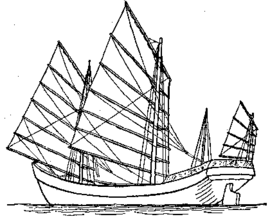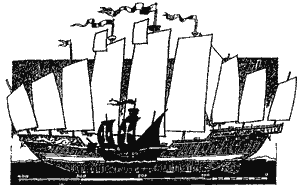Junk (sailing)
|
|
The Junk is a Chinese sailing vessel. The English name comes from Malay dgong or jong. Junks were originally developed during the Han Dynasty (220 BCE-200 CE) and further evolved to represent one of the most successful ship types in history.
| Contents [hide] |
|
|
Design
Junks are efficient and sturdy ships that were traveling across oceans as early as the 2nd century CE. They incorporated numerous technical advances in sail plan and hull designs that were later adopted in Western shipbuilding.
The historian H. Warington Smith considered the junk as one of the most efficient of ship designs:
- "As an engine for carrying man and his commerce upon the high and stormy seas as well as on the vast inland waterways, it is doubtful if any class of vessel is more suited or better adapted to its purpose than the Chinese junk, and it is certain that for flatness of sail and handiness, the Chinese rig is unsurpassed." (H. Warington Smith)
Sail plan
The structure and flexibility of the sails make the junk easy to sail, and fast since the sails are not square rigged, i.e. they can be angled when sailing upwind.
The sails are cut elliptically and slightly curved with bamboo inserts (battens), giving them the shape of an airfoil, and permitting them to sail well on any point of sail. The sails can also be easily reefed and adjusted for fullness, to accommodate various wind strengths. The battens also give the sails added strength, and make them more resistant than traditional sails to holing or rot. Junk sails have much in common with the most aerodynamically efficient sails used today in windsurfers or catamarans, although their design can be traced back as early the 3rd century CE.
The rigging is very simple, because bamboo is very strong, and thus fewer ropes are needed.
The sail-plan is also spread out between multiple masts, allowing for a powerful sail surface, and a good repartition of efforts, an innovation adopted in the West around 1304. The rig is fore-and aft, allowing for good sailing into the wind.
Hull design
Classic junks were built of teak with multiple water-tight compartments, accessed by separate hatches and ladders: similar in structure to the interior stem of bamboo. The largest junks were built for world exploration in the 1200s, and exceeded 150 meters in length.
Rudders
Junks employed stern-mounted rudders centuries before their adoption in the West, an innovation which permitted the steering of large, high-freeboard ships. The world's oldest known depiction of a stern-mounted rudder can be seen on a pottery model of a junk dating from the 1st century CE. By contrast, the West's oldest known stern-mounted rudder can be found on church carvings dating to around 1180.
Also, many junks incorporated "fenestrated rudders" (rudder with holes in them, allowing for better control), an innovation adopted in the West in 1901 to increase the manoeuvrability of torpedo boats.
Watertight compartments
Another characteristic of junks, watertight compartments allowed to reinforce the ship structure and to preserve its integrity even in case of holing. This innovation was recognized and adopted in the West during the 18th century.
Benjamin Franklin wrote in a 1787 letter on the project of mail packets between the United States and France:
- "As these vessels are not to be laden with goods, their holds may without inconvenience be divided into separate apartments, after the Chinese manner, and each of these apartments caulked tight so as to keep out water" (Benjamin Franklin, 1787)
In 1795, the Lords Commissioners of the Admiralty in Great Britain asked Sir Samuel Bentham, chief engineer and architect of the Royal Navy, to design six new sailing ships with "partitions contributing to strength, and securing the ship against foundering, as practiced by the Chinese of the present day". Bentham had been in China in 1782, and he acknowledged that he had got the idea of watertight compartments by looking at Chinese junks there.
Leeboards & centerboard
Leeboards and centerboard, used to stabilize the junk and to improve its capability to sail upwind are documented from a 759 CE book by Li Chuan, an innovation adopted by Portuguese and Dutch ships around 1570.
Other innovations included the square-pallet bilge pump, which were adopted by the West during the 16th century. Junks also relied on the compass for navigational purposes.
History
Junks were originally developed during the Han Dynasty (220 BCE-200 CE).
2nd century junks (Han Dynasty)
The 3rd century book "Strange Things of the South" (南州異物志) by Wan Chen (萬震) describes junks capable of carrying 700 people together with 260 tons of cargo ("more than 10,000 "斛"). He explains the ship's design as follows:
- "The four sails do not face directly forward, but are set obliquely, and so arranged that they can all be fixed in the same direction, to receive the wind and to spill it. Those sails which are behind the most windward one receiving the pressure of the wind, throw it from one to the other, so that they all profit from its force. If it is violent, (the sailors) diminish or augment the surface of the sails according to the conditions. This oblique rig, which permits the sails to receive from one another the breath of the wind, obviates the anxiety attendant upon having high masts. Thus these ships sail without avoiding strong winds and dashing waves, by the aid of which they can make great speed" ("Strange Things of the South", Wan Chen, from Robert Temple).
A 260 CE book by Kang Tai (康泰) also described ships with seven masts, traveling as far as Syria.
14th century junks (Yuan Dynasty)
The enormous characteristics of the Chinese ships of the Medieval period is described in Chinese sources, and is confirmed by Western travelers to the East, such as Marco Polo, Ibn Battuta and Nicolo Da Conti. According to Ibn Battuta, who visited China in 1347:

- ... We stopped in the port of Calicut, in which there were at the time thirteen Chinese vessels, and disembarked. On the China Sea traveling is done in Chinese ships only, so we shall describe their arrangements. The Chinese vessels are of three kinds; large ships called chunks (junks), middle sized ones called zaws (dhows) and the small ones kakams. The large ships have anything from twelve down to three sails, which are made of bamboo rods plaited into mats. They are never lowered, but turned according to the direction of the wind; at anchor they are left floating in the wind.
- A ship carries a complement of a thousand men, six hundred of whom are sailors and four hundred men-at-arms, including archers, men with shields and crossbows, who throw naphtha. Three smaller ones, the "half", the "third" and the "quarter", accompany each large vessel. These vessels are built in the towns of Zaytun (a.k.a Zaitun; today's Quanzhou; 刺桐) and Sin-Kalan. The vessel has four decks and contains rooms, cabins, and saloons for merchants; a cabin has chambers and a lavatory, and can be locked by its occupants.
- This is the manner after which they are made; two (parallel) walls of very thick wooden (planking) are raised and across the space between them are placed very thick planks (the bulkheads) secured longitudinally and transversely by means of large nails, each three ells in length. When these walls have thus been built the lower deck is fitted in and the ship is launched before the upper works are finished. (Ibn Battuta).
Niccolo Da Conti in his relations of his travels in Asia between 1419 and 1444, matter-of-factly describes huge junks of about 2,000 tons, more than four times the size of 16th century Western galleons:
- They make ships larger than ours, about 2,000 tons in size, with five sails and as many masts. The lower part is made of three decks, so as to better resist storms, which occur frequently. These ships are separated into several compartments, so that if one is touched during a storm, the others remain intact." (Niccolo Da Conti)
15th century junks (Ming Dynasty)
The largest junks ever built were probably those of Admiral Zheng He, for his expeditions in the Indian Ocean. According to Chinese sources, the fleet comprised 30,000 men and over 300 ships at its height.
The 1405 expedition consisted of 27,000 men and 317 ships, composed of:
- "Treasure ships", used by the commander of the fleet and his deputies (Nine-masted junks, about 400 feet long and 160 feet wide).
- "Horse ships", carrying tribute goods and repair material for the fleet(Eight-masted junks, about 339 feet long and 138 feet wide)
- "Supply ships", containing food-staple for the crew (Seven-masted junks, about 257 feet long and 115 feet wide).
- "Troop transports" (Six-masted junks, about 220 feet long and 83 feet wide).
- "Fuchuan warships" (Five-masted junks, about 165 feet long).
- "Patrol boats" (Eight-oared, about 120 feet long).
- "Water tankers", with 1 month supply of fresh water and sustainability.
19th century junks (Qing Dynasty)
ChineseJunkKeying.jpg
Junks remained considerable in size and played a key role in Asian trade until the 19th century. One of these junks, Keying, sailed from China around the Cape of Good Hope to the United States and England between 1846 and 1848. She testifies to the power of Chinese shipping and shipbuilding at the time of the beginning of industrialization in the West.
The Keying was praised by the English as excellent in sea-worthiness, and practically superior to their own:
- "She proved herself an excellent sea-boat; and her powers of weathering a storm equal, if not surpass, those of vessels of British build." (Illustrated London News, 1848)
She was also fast, sailing between Boston and England in 21 days:
- "The Keying next visited Boston, whence she sailed direct for London on the 17th of February last, and arrived in St Aubin's Bay, Jersey, on the 15th March, having performed the voyage, from land to land, in 21 days - a short period even for the American packet-ships." (Illustrated London News, 1848)
References
- Pirates and Junks in Late Imperial South China (http://mannequinzoo.org/junks)
See also
Other Rigs
Template:Sailing Vessels and Rigsda:Junke de:Dschunke id:Kapal Jung pl:Dżonka sv:Djonk


